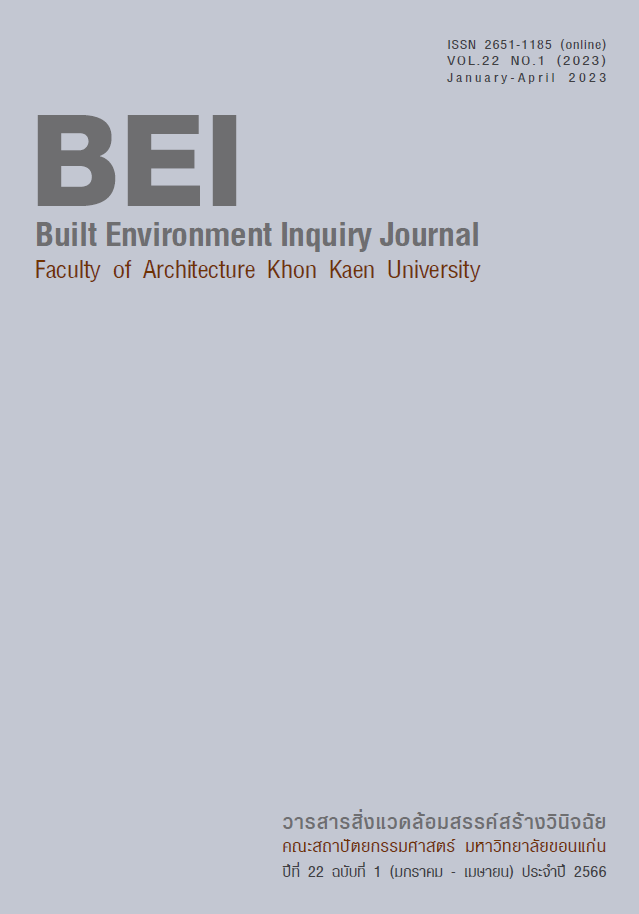อุณหภูมิผิวหนังและความรู้สึกเชิงความร้อน: การศึกษาเบื้องต้นสำหรับการพัฒนาแบบจำลองสภาวะน่าสบายเชิงบุคคลที่อาศัยการตอนสนองทางสรีรวิทยา
DOI:
https://doi.org/10.14456/bei.2023.4คำสำคัญ:
สภาวะน่าสบาย ความรู้สึกเชิงความร้อน การตอบสนองทางสรีรวิทยา อุณหภูมิผิวหนังใบหน้าบทคัดย่อ
สภาวะน่าสบายภายในอาคารเป็นเป้าหมายที่สําคัญในการออกแบบอาคารและการจัดการในอาคารเนื่องจากมีความสำคัญอย่างยิ่งต่อของผู้ใช้อาคารในหลายมิติ แบบจำลองสภาวะน่าสบายเชิงบุคคล (PCM) เป็นแนวทางใหม่ในการประเมินสภาวะน่าสบายซึ่งมุ่งแก้ปัญหาความแตกต่างระหว่างบุคคลซึ่งเป็นข้อจำกัดของแบบจำลองดั้งเดิม PCM มุ่งที่จะทำนายสภาวะน่าสบายของผู้ใช้อาคารแต่ละคนโดยอาศัยการตอบสนองโดยตรงจากผู้ใช้ ผิวหนังเป็นส่วนของร่างกายที่สำคัญในกลไกควบคุมอุณหภูมิดังนั้นอุณหภูมิผิวหนังจึงถูกนำมาใช้อย่างกว้างขวางในการศึกษาก่อนหน้า อย่างไรก็ดีการศึกษาเกี่ยวกับ PCM นี้ยังอยู่ในวงจำกัด ดังนั้นในการวิจัยนี้จึงมีวัตถุประสงค์เพื่อศึกษาอุณหภูมิผิวหนังใบหน้า ลักษณะการเปลี่ยนแปลงอุณหภูมิผิวหนัง และวิเคราะห์ความสัมพันธ์ระหว่างอุณหภูมิผิวหนังใบหน้ากับความรู้สึกเชิงความร้อนภายใต้สภาพอุณหภูมิที่เปลี่ยนแปลง เพื่อนำไปสู่การพัฒนาแบบจำลองสภาวะน่าสบายเชิงบุคคลที่อาศัยอุณหภูมิผิวหนังของผู้ใช้อาคารในสภาพอากาศร้อนชื้น การวิจัยนี้ได้ทำการเก็บข้อมูลจากอาสาสมัครที่คุ้นชินกับสภาพอากาศร้อนชื้นภายในห้องทดลองที่มีการไล่ระดับอุณหภูมิระหว่าง 21 ถึง 29oC อุณหภูมิผิวหนังใบหน้าถูกรวบรวมด้วยกล้องอินฟราเรด ขณะที่ความรู้สึกเชิงความร้อนถูกสำรวจด้วยแบบสอบถาม ผลการศึกษาแสดงให้เห็นความสัมพันธ์กันระหว่างอุณหภูมิผิวหนังกับความรู้สึกเชิงความร้อนซึ่งชี้ให้เห็นถึงแนวทางที่เหมาะสมในการพัฒนาแบบจำลองสภาวะน่าสบายเชิงบุคคลในอนาคต
เอกสารอ้างอิง
Arens, E., & Zhang H., (2006). The skin’s role in human thermoregulation and comfort. In N. Pan and P. Gibson (Eds.), Thermal and Moisture Transport in Fibrous Materials (Issue January 2020). https://doi.org/10.1533/9781845692261.3.560
Aryal, A., & Becerik-Gerber, B. (2019). Skin temperature extraction using facial landmark detection and thermal imaging for comfort assessment. BuildSys 2019 - Proceedings of the 6th ACM International Conference on Systems for Energy-Efficient Buildings, Cities, and Transportation, 71–80. https://doi.org/10.1145/3360322.3360848
ASHRAE. (2017). ANSI/ASHRAE Standard 55-2017: Thermal Environmental Conditions for Human Occupancy. ASHRAE Inc.
Chaudhuri, T., Soh, Y. C., Li, H., & Xie, L. (2020). Machine learning driven personal comfort prediction by wearable sensing of pulse rate and skin temperature. Building and Environment, 170. https://doi.org/10.1016/j.buildenv.2019.106615
Chaudhuri, T., Zhai, D., Chai, Y., Li, H., & Xie, L. (2018). Random forest based thermal comfort prediction from gender-specific physiological parameters using wearable sensing technology. Energy & Buildings, 166, 391–406.
Choi, J. H., & Yeom, D. (2017). Study of data-driven thermal sensation prediction model as a function of local body skin temperatures in a built environment. Building and Environment, 121, 130–147. https://doi.org/10.1016/j.buildenv.2017.05.004
Dai, C., Zhang, H., Arens, E., & Lian, Z. (2017). Machine learning approaches to predict thermal demands using skin temperatures : Steady-state conditions. Building and Environment, 114(August 2017), 1–10. https://doi.org/10.1016/j.buildenv.2016.12.005
Deng, Z., & Chen, Q. (2018). Artificial neural network models using thermal sensations and occupants’ behavior for predicting thermal comfort. Energy and Buildings, 174, 587–602. https://doi.org/10.1016/j.enbuild.2018.06.060
Fanger, P.O. 1970. Thermal Comfort Analysis and Application in Environmental Engineering. New York: McGraw-Hill.
Faridah, F., Waruwu, M. M., Wijayanto, T., Budiarto, R., Pratama, R. C., Prayogi, S. E., Nadiya, N. M., & Yanti, R. J. (2021). Feasibility study to detect occupant thermal sensation using a low-cost thermal camera for indoor environments in Indonesia. Building Services Engineering Research and Technology, 2. https://doi.org/10.1177/0143624421994015
FLIR. (2013). User’s manual FLIR Ex series. FLIR Systems. Retrieved from https://www.flir.com/globalassets/imported-assets/document/flir-ex-series-user-manual.pdf
Geng, Y., Ji, W., Lin, B., & Zhu, Y. (2017). The impact of thermal environment on occupant IEQ perception and productivity. Building and Environment, 121, 158–167. https://doi.org/10.1016/j.buildenv.2017.05.022
Katić, K., Li, R., & Zeiler, W. (2020). Machine learning algorithms applied to a prediction of personal overall thermal comfort using skin temperatures and occupants’ heating behavior. Applied Ergonomics, 85(November 2019). https://doi.org/10.1016/j.apergo.2020.103078
Kim, J., Schiavon, S., & Brager, G. (2018). Personal comfort models – A new paradigm in thermal comfort for occupant-centric environmental control. Building and Environment, 132, 114–124. https://doi.org/10.1016/j.buildenv.2018.01.023
Li, D., Menassa, C. C., & Kamat, V. R. (2017). Personalized human comfort in indoor building environments under diverse conditioning modes. Building and Environment, 126(July), 304–317. https://doi.org/10.1016/j.buildenv.2017.10.004
Li, D., Menassa, C. C., & Kamat, V. R. (2018). Non-intrusive interpretation of human thermal comfort through analysis of facial infrared thermography. Energy and Buildings, 176, 246–261. https://doi.org/10.1016/j.enbuild.2018.07.02
Liu, S., Schiavon, S., Das, H. P., Jin, M., & Spanos, C. J. (2019). Personal thermal comfort models with wearable sensors. Building and Environment, 162. https://doi.org/10.1016/j.buildenv.2019.106281
Lu, S., Hameen, E. C., & Zou, Y. (2019). An interactive building control for the integrative HVAC system featuring personalized cooling in office buildings. ASHRAE Transactions, 125(June), 389–397.
Mujan, I., Anđelković, A. S., Munćan, V., Kljajić, M., & Ružić, D. (2019). Influence of indoor environmental quality on human health and productivity - A review. Journal of Cleaner Production, 217, 646–657. https://doi.org/10.1016/ j.jclepro.2019.01.307
Pigliautile, I., Casaccia, S., Morresi, N., Arnesano, M., Pisello, A. L., & Revel, G. M. (2020). Assessing occupants’ personal attributes in relation to human perception of environmental comfort: Measurement procedure and data analysis. Building and Environment, 177, 106901. https://doi.org/https://doi.org/10.1016/j.buildenv.2020.106901
Pritoni, M., Salmon, K., Sanguinetti, A., Morejohn, J., & Modera, M. (2017). Occupant thermal feedback for improved efficiency in university buildings. Energy and Buildings, 144, 241–250. https://doi.org/10.1016/j.enbuild.2017.03.048
Salehi, B., Ghanbaran, A. H., & Maerefat, M. (2020). Intelligent models to predict the indoor thermal sensation and thermal demand in steady state based on occupants’ skin temperature. Building and Environment, 169(December 2019), 106579. https://doi.org/10.1016/j.buildenv.2019.106579
Wang, Z., de Dear, R., Luo, M., Lin, B., He, Y., Ghahramani, A., & Zhu, Y. (2018). Individual difference in thermal comfort: A literature review. Building and Environment, 138(February), 181–193. https://doi.org/10.1016/j.buildenv.2018.04.040
Wang, Z., Zhang, H., He, Y., Luo, M., Li, Z., Hong, T., & Lin, B. (2020). Revisiting individual and group differences in thermal comfort based on ASHRAE database. Energy and Buildings, 219. https://doi.org/10.1016/j.enbuild.2020.110017
Yang, B., Cheng, X., Dai, D., Olofsson, T., Li, H., & Meier, A. (2019). Real-time and contactless measurements of thermal discomfort based on human poses for energy efficient control of buildings. In Building and Environment (Vol. 162). https://doi.org/10.1016/j.buildenv.2019.106284
ดาวน์โหลด
เผยแพร่แล้ว
รูปแบบการอ้างอิง
ฉบับ
ประเภทบทความ
สัญญาอนุญาต
ลิขสิทธิ์ (c) 2023 สิ่งแวดล้อมสรรค์สร้างวินิจฉัย

อนุญาตภายใต้เงื่อนไข Creative Commons Attribution-NonCommercial-NoDerivatives 4.0 International License.
ทัศนะและข้อคิดเห็นของบทความที่ปรากฏในวารสารฉบับนี้เป็นของผู้เขียนแต่ละท่าน ไม่ถือว่าเป็นทัศนะและความรับผิดชอบของกองบรรณาธิการ




